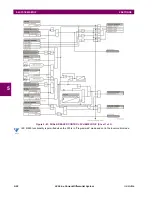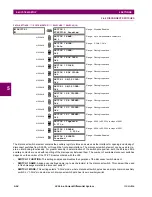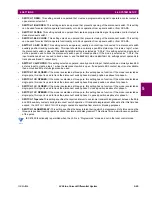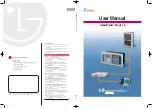
5-106
L90 Line Current Differential System
GE Multilin
5.4 SYSTEM SETUP
5 SETTINGS
5
Depending on the applied filter, the Synchrophasors that are produced by PMUs are classified as either P (protection) or M
(Measurement) class Synchrophasors. Synchrophasors available within the UR that have no filtering applied are classified
as NONE which within the standard is classified as PRES OR UNKNOWN under the Calculation Method - ClcMth. Each
Logical Device PMU supports one MxxMMXU, MxxMSQI, PxxxMMXU , PxxxMSQI, NxxMMXU, and one NxxMSQI logical
node.
Figure 5–39: LOGICAL NODES SUPPORTED IN EACH LOGICAL DEVICE
The following is a summary of LNs that are in each Logical Device (LD2 through LD5):
- PxxxMMXU1 ClcMth = P-Class
- PxxxMSQI1 ClcMth = P-CLASS (Note Vx is mapped to Vneut of MMXU)
- MxxMMXU1 ClcMth = M-Class
- MxxMSQI1 ClcMth = M-CLASS (Note Vaux is mapped to VN of MMXU)
- NxxMMXU1 ClcMth = M-Class
- NxxMSQI1 ClcMth = M-CLASS (Note Vx is mapped to Vneut of MMXU)
- xxxxGGIO1- GGIO1 which contains 16 digital status indication points and 16 analog points. The Analog GGIO values are
selectable from any FlexAnalog value in the UR.
All Synchro Logical Nodes in an LD report at the same rate as set in the PMUn Basic Configuration setting in the
UR. This is reflected in the instantiation of the Data Object – SmpRate in the LLN0 of each LD. SmpRate is a Read
Only Integer Status (INS) and takes on, as a value, the setting of the Sample Rate in each LD/PMU.
When the first PMU from any LD is mapped into an aggregator, the aggregator inherits the Sample Rate (SmpRate) and
C37.118 Class (P or M) of that PMU. The value of the SmpRate DO in the Report Control Block is set based on the value
of the Sample Rate in the PMU. The Class of the Dataset are mapped into the MSVID of the Dataset (see text below for
the overall name of the MSVID). If other PMUs are mapped into the same aggregator with different Sample Rates or from
different classes, then a Self-Test error (DatSetErr) is set and dataset transmission is blocked.
A setting value – MSVID – is created with a maximum input range of 56 characters (=64 less 6 for the IDCode less 2 for the
Class).
The value of MSVID in the dataset is a concatenation of the aggregator IDCode and the MSVID setting value in the format:
MSVID-AggregatorIDCode-CLASS where CLASS is P, M, or N (for None) – depending on the Class of the first PMU loaded
into the Aggregator.
Synchrophasor Rectangular Format and Integer data types are NOT supported in IEC 61850-90-5 and not to set –
- GGIO1 which contains 16 digital status indication points – aggregated as a 16 bit bitstring and 16 analog points.
The Analog GGIO values are selectable from any FlexAnalog value in the UR. For version 7.0 the description fields
for the phasors, analog and digital channels are populated with the 16 character name field provided within the
Basic Configuration menu. Additionally, the names of the 16 binary points are implemented as numbered descriptions – d1,
d2, d3, etc. The number of descriptions are equal to the number of bits configured in the 16 bit digital status word.
All bitstrings less than or equal to 32 bits in length map into a 32 bit bitstring in an IEC 61850-90-5 dataset.
NOTE
NOTE
NOTE
Summary of Contents for UR Series L90
Page 652: ...A 16 L90 Line Current Differential System GE Multilin A 1 PARAMETER LISTS APPENDIX A A ...
Page 772: ...B 120 L90 Line Current Differential System GE Multilin B 4 MEMORY MAPPING APPENDIX B B ...
Page 802: ...C 30 L90 Line Current Differential System GE Multilin C 7 LOGICAL NODES APPENDIX C C ...
Page 812: ...D 10 L90 Line Current Differential System GE Multilin D 1 IEC 60870 5 104 APPENDIX D D ...
Page 824: ...E 12 L90 Line Current Differential System GE Multilin E 2 DNP POINT LISTS APPENDIX E E ...
Page 834: ...F 10 L90 Line Current Differential System GE Multilin F 3 WARRANTY APPENDIX F F ...
Page 846: ...xii L90 Line Current Differential System GE Multilin INDEX ...
















































